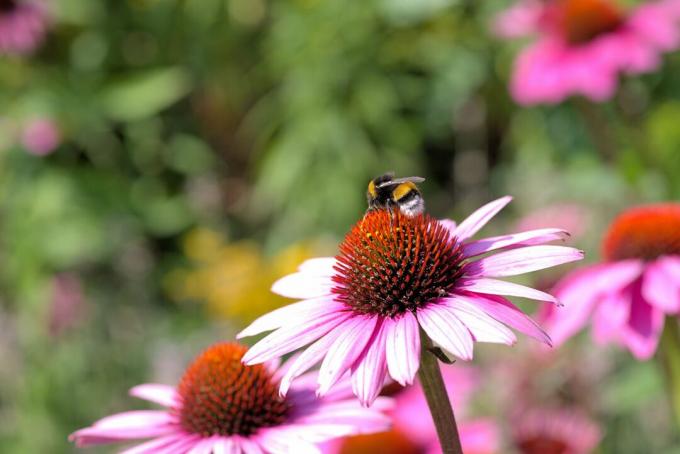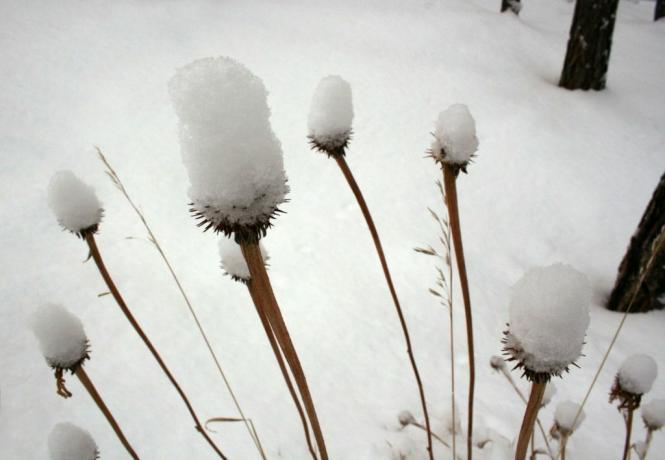The sun hat creates a summery atmosphere in the garden. Here you can find out everything about planting, caring for and propagating the sun hat.

The sun hats (Echinaceae) are also often called hedgehog heads or false sun hats and beautify every garden with their wonderful and colorful flowers. Here we show you what is important when cultivating sun hats so that you can enjoy these perennials for a long time.
contents
- Sun hat: origin and characteristics
- Is the sun hat perennial?
- Coneflower types and varieties
- Purple coneflower
- Yellow sun hat
- Buying a coneflower plant: this is important to note
- Plant sun hat
- Propagate the coneflower
- Maintain a sun hat
- Watering the sun hat
- Cut sun hat
- Fertilize the coneflower
- Hibernate the coneflower
- Is the sun hat poisonous?
- Coneflower as a medicinal plant
The coneflower is a popular garden perennial and is also perfect for beginners because it is a relatively easy-care plant. Here you can find out what you should still pay attention to when caring for sun hats.
Sun hat: origin and characteristics
The coneflower belongs to the daisy family (Asteraceae), all types of sun hats are native to North America. They can reach heights of 60 to 180 centimeters and mostly have tap roots that allow you to absorb water and nutrients from deeper layers of the soil. The coneflower forms clumps, because it not only drives out a hairy stem, but also several stems. The leaves are also rough and hairy and can be up to 20 centimeters long.
The flowers have a brownish, prickly center, around which the domed petals are formed. These petals are usually pink to purple in color and have a very attractive effect Bees and butterflies. There are now specially bred varieties that have a whitish or yellow color. The appearance of the coneflower is very similar to the rudbeckia (Rudbeckia), but these are a completely different genus. The flowers of the coneflower usually appear in summer from July and can bloom into September. The coneflower can be sown from March to June.

Is the sun hat perennial?
Sun hats are perennial herbaceous plants, which means that while they cannot lignify, they can live for several years and usually bloom annually as well. Your coneflower can easily overwinter outdoors - you don't have to worry about a lot.
Coneflower types and varieties
When we talk about sun hats, from a botanical point of view we are always talking about plants from the genus Echinaceae, however, in our language usage there are also other plants that look similar and are also called coneflowers, but do not belong to this genus. Here you can learn more about these - sometimes confusing - types of coneflowers.
Purple coneflower
The purple coneflower (Echinacea purpure), which is also known as the red pseudo-sun hat, has wonderful, large daisy-like flowers in a purple-red color. The purple coneflower prefers a sunny place with a humus-rich soil and then flowers from July to September. This species is often used as a medicinal plant for colds or to strengthen the immune system.
Yellow sun hat
The yellow coneflower is also known as the common coneflower and belongs to the rudbeckia plant genus (Rudbeckia). This genus also comes from North America and is often used as an ornamental plant. These plants got the name "sun hat" from their yellow flowers, which are reminiscent of the sun, however, they do not belong to the genus of the sun hats and these plants are not used as either Medicinal herb.

Buying a coneflower plant: this is important to note
You can buy the coneflower as seeds in bags or you can already buy whole coneflower plants. When buying seeds, you should always pay attention to the quality and also whether the packaging is still intact, clean and, above all, dry. You can also find a filling or expiration date on the seed bags. If this date has passed, the germinability of the seeds may already be impaired, which means that the seeds can no longer germinate. However, you can also simply harvest the coneflower seeds from existing plants in your garden. You can find out what you need to know here.
When buying coneflower plants, you should always pay attention to plant health so that you are also bringing home healthy and resilient plants. In addition, of course, nobody wants to introduce pests or diseases with a purchased garden plant. Therefore, check the plant for signs of feeding, egg clutches from pests such as before buying Weevils (Curculionidae) or Aphids (Aphidoidea), which are often located on the underside of the leaves, and whether there is a fungal lawn on the leaves or stems. Sun hats are particularly likely to be attacked and damaged by snails. The coneflower is also endangered by Powdery mildew mushrooms becoming infested, which could then spread to other plants in your garden.
Plant sun hat
A good start is essential so that you can enjoy your sun hat in the garden. The right location in particular is very important for good growth - with the sun hat this should be a sunny place without waterlogging. Here in our special article you will learn the most important things about Planting sun hats.

Propagate the coneflower
The coneflower can be propagated in different ways - either via seeds, dividing or vegetatively via cuttings. In our special article on Propagation of the coneflower you will find the most important information about these three types of propagation and how best to go about them.
Maintain a sun hat
In order to be able to care for the sun hat optimally, you should put it in the right place right from the start. As already mentioned, the sun hat thrives best in a sunny spot in your garden. If you only move the coneflower to a partially shaded spot, it will produce fewer flowers. During the growing season, it is also advisable to loosen the soil around the coneflower with a garden rake every now and then.
Watering the sun hat
The sun hat likes it moist, but you should definitely avoid waterlogging. The plant is best watered in the cool evening hours, but the coneflower can also survive dry periods outdoors - but then it will develop fewer flowers. Sun hats planted in a tub should be watered regularly to prevent drying out. Because of their tap roots, they can only absorb water from deeper soil layers outdoors.
Cut sun hat
The coneflower is a very easy to care for garden plant, also in terms of cut. Of course, you can cut off the wonderful flowers in summer and use them to decorate in a vase or to make a beautiful summer bouquet. Once a year, however, the coneflower has to be cut back to encourage growth. Here we tell you what it's all about Cut of sun hats must be observed.

Fertilize the coneflower
The coneflower needs nutrient-rich soil that is not too heavy for optimal growth. In addition, it should be more permeable to water for the sun hat to avoid waterlogging. If your soil is too firm, you can add a primarily organic fertilizer to promote the build-up of humus and thus make the soil more permeable. Such fertilization for sun hats outdoors is also ideal in spring. Our is suitable for this Plantura organic flower fertilizer ideal. If you have planted the coneflower in the tub, you can also have one Liquid fertilizer use to provide nutrients to the plant.
Hibernate the coneflower
As already mentioned, the coneflower is perennial and can hibernate outdoors without any problems. In autumn you can even leave the faded stems standing, to decorate your garden in winter. The underground parts of the coneflower are hardy. In spring, the above-ground parts of the plant are then simply cut back before the new shoots.
It is different with sun hats in the bucket. These are more prone to frost, as the bucket itself and the little soil in it cannot provide ideal protection from the cold - hence It is advisable to always apply frost protection for potted plants or to keep the potted plant indoors for the cold months bring. It is best to place the sun hat on a styrofoam plate so that it is protected from the cold from below. In addition, you can wrap the bucket with a garden fleece or protect it with brushwood. So your sun hat can easily get through the winter and you can enjoy the beautiful perennial again next spring.

Is the sun hat poisonous?
The coneflower is not poisonous to humans or animals, which is also confirmed by the fact that it is has been used as a medicinal plant for a long time and is also used again and again in homeopathy encountered. So you don't have to worry if your pets gnaw on the coneflower plant, as there are no toxic substances in any part of the plant. The purple coneflower can even be eaten without any problems and many use the aromatic flower petals in salads or teas. But only use the petals, because the center of the flower is prickly, hard and not very tasty.
Coneflower as a medicinal plant
The coneflower is not only known as a wonderful ornamental plant, but has certainly also met some, who had a cold or were looking for a remedy to boost their immune system during the flu season strengthens. The coneflower was already used by the Native Americans as a medicinal herb for sore throats and coughs.
Today, the following three types of coneflowers are mainly used for diseases of the respiratory and urinary tract:
- Echinacea purpurea
- Echinacea pallida
- Echinacea angustifolia

The effect of sun hat products as a remedy is controversial, because many studies have already been carried out with very different results. Despite everything, the sun hat is widely used in homeopathy. The pressed juice of the coneflower as well as a tincture and extracts from it are used and should strengthen the body's defenses, have an anti-inflammatory effect and be antibacterial.



